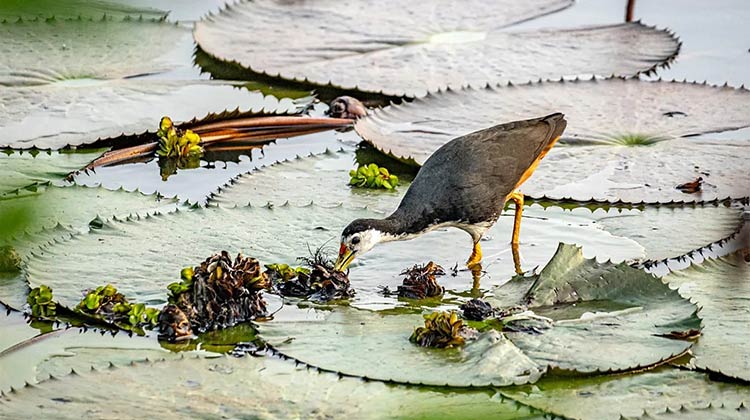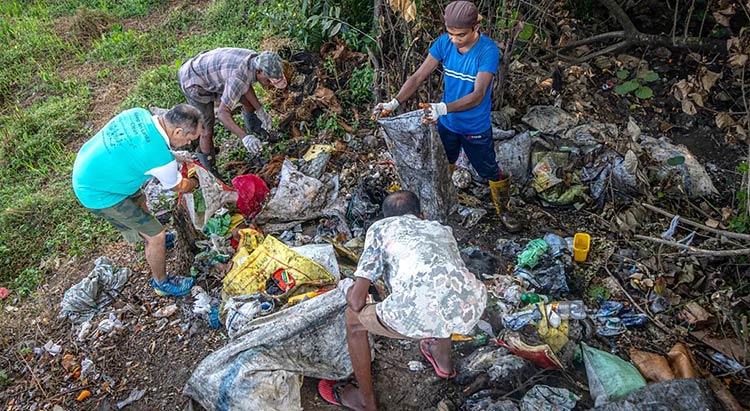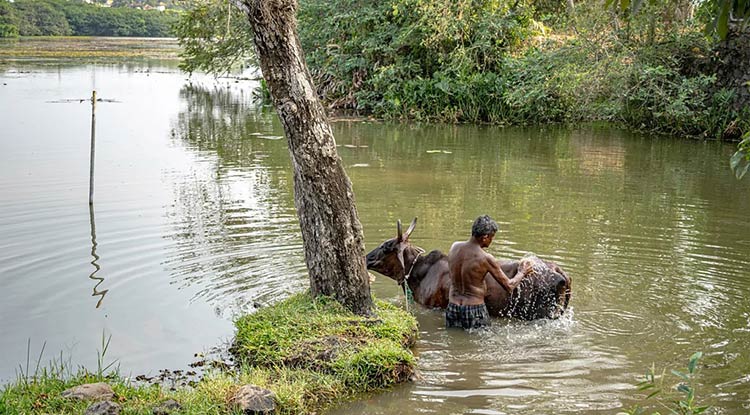Life style
Australian company has a plan to mine sands

Mannar Island is a bird paradise that survived Sri Lanka’s civil war
Two thousand flamingos and a war-torn island: controversy over Australian mine proposal
Have you heard of Sri Lanka’s Mannar Island?
Up to a million migrating birds seek sanctuary here each year on their gruelling journeys South, and thousands of flamingos call the island home too.
It’s also home to the survivors of a 26-year civil war, who are still rebuilding their lives and rely on the island for their subsistence livelihoods.
An Australian ASX-listed company wants to mine on the island for mineral sands – a booming global industry extracting vital minerals for a multitude of uses.
But Sri Lankan scientists, environmentalists, and human rights activists are concerned about the impact a mine could have, and dismayed about the lack of information on what’s proposed.
Science Friction investigates.
by environment reporter Nick Kilvert and Jane Lee for Science Friction
As a small child, Shreen Abdul Saroor remembers getting up before dawn with her father to spy on the masses of migratory birds that would visit her island.
The birds were on their way down the Central Asian flyway — a migration path that crosses 30 countries from Siberia to the Indian Ocean.
“We would hide somewhere and … we don’t make any noise,” Ms Saroor recalls.
“[Then we’d watch] them coming and landing in the causeway areas and then catching fish and taking off as a huge group covering the entire sky.”
Up to a million birds stop at Mannar Island, off the north-west coast of Sri Lanka, to feed during the winter.
 The Vankalai Bird Sanctuary on the southern tip of the island is protected by the Sri Lankan government and has been internationally recognised under the Ramsar Convention for its importance to both local and migratory birds.
The Vankalai Bird Sanctuary on the southern tip of the island is protected by the Sri Lankan government and has been internationally recognised under the Ramsar Convention for its importance to both local and migratory birds.
Ms Saroor also remembers climbing the swollen trunks and gnarled branches of the baobab trees — trees synonymous with Africa, Madagascar and Australia’s Kimberley, but also found incongruously on her tiny island.
“Even though I fondly remember these baobab trees, one thing that I really remember is how … [members of the militant separatist group the Tamil Tigers] put the mutilated heads of the Indian peacekeeping forces on those trees.”
The Liberation Tigers of Tamil Eelam fought a 30-year civil war with majority Sinhalese Sri Lankan military, in an attempt to create an independent Tamil homeland in the north and east of the country.
Ms Saroor had already left the island to study in Colombo in 1990 when the Tamil Tigers forced her remaining family off Mannar Island, along with all the other Muslim residents.
“Everybody overnight became refugees,” she says.
Since the war ended in 2009, many displaced Mannar Islanders have returned to re-establish themselves in fishing and farming communities. But the trauma still lingers and there are tensions over land.
Against this backdrop, an Australian company has a plan to mine Mannar’s sands.
There are fears for the island’s fragile ecology, agriculture and fishing areas — and islanders are worried they could be displaced all over again.
Company’s drilling triples estimate of island’s minerals
Mannar is the biggest island at the base of a narrow chain of limestone shoals known as Rama Setu or Adam’s Bridge, which stretches 48 kilometres north-west to join India.
The island is 26km long by 8km wide and has rich deposits of the mineral ilmenite in its sand.
Ilmenite is the main source of titanium dioxide, a valuable white pigment used in things like paints, ink, plastics and cosmetics.
In 2018, Perth-based company Titanium Sands advised the Australian Securities Exchange (ASX) it entered an agreement with Srinel Holdings Ltd to explore the extent of the island’s ilmenite reserves.
 In May this year, the company announced their exploratory drilling had tripled the previous estimate — to a total of just under 265 million tonnes.
In May this year, the company announced their exploratory drilling had tripled the previous estimate — to a total of just under 265 million tonnes.
Managing director of Titanium Sands, James Searle, says the company is looking to mine an area of the island that is 2km wide and about 8km long.
“That’s probably over a 30-plus year lifespan,” he told ABC RN’s Science Friction.
“On an annualised basis that’s probably … in the region of between 10 and 16 hectares.”
But some Sri Lankan scientists and environmentalists say they have been inadequately informed about the project.
‘The machines are moving in’
Ms Saroor’s younger brother is one of those who have made it back to the island, where he has a coconut estate.
“The first time I heard about this Titanium Sands mining is from him,” Ms Saroor says.
“He called me frantically and said there are machines moving in and out of those areas.”
Companies that Titanium Sands acquired started preliminary assessment with small-scale drilling on the island in 2015.
Throughout the totality of their study, which included a scoping study completed this year, the company drilled more than 3,000 exploratory holes with the deepest going down to 12 metres. The majority were between 1 and 3 metres.
According to Dr Searle, there has been no drilling in built-up areas of the island.
“The population on the island is largely concentrated in a town down the landward end of the island, called Mannar Town. There are other coastal villages, other settlements around the island,” he says.
“Our exploration work is only being undertaken on areas where there is no habitation and where there is no active agriculture.”
It’s some of those undeveloped areas of Mannar Island that concern ecologist Sampath Seneviratne, who studies Mannar’s birds.
“Flamingos must be the most charismatic and sought-after in terms of beauty,” he says. “[But] spoon-billed sand piper, one of the rarest birds in the world and one of the most iconic species that are on the verge of extinction right now, has been recorded in Mannar.
“These birds require highly productive places to feed during their migration and during their winter stopover. So if the productivity drops, they can’t use Mannar, they have to go [to] other places.”
According to Dr Seneviratne, a public notice is usually issued when companies are given permission for mining exploration in Sri Lanka.
But he and his colleague at the Wildlife Protection Society only found out from a friend in Australia about the drilling, and they were surprised that local environmental groups knew nothing of the project.
“It was a big shocker, because how did people like us working in [Mannar] not know
Company accused of illegal conduct by Mines Bureau
Earlier this year in June, Titanium Sands was accused of illegal conduct in local Sri Lankan media reports.
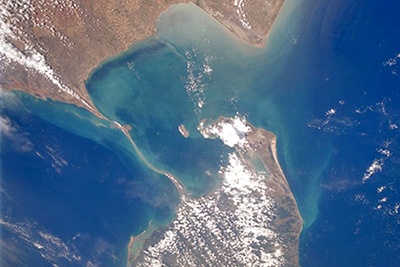 The Sri Lankan Geological Surveys and Mines Bureau (GSMB) — the government body responsible for issuing mining and exploration licenses in Sri Lanka — reportedly said the company’s exploration was unlawful.
The Sri Lankan Geological Surveys and Mines Bureau (GSMB) — the government body responsible for issuing mining and exploration licenses in Sri Lanka — reportedly said the company’s exploration was unlawful.
The GSMB told local media that under Sri Lankan law, Titanium Sands couldn’t legally acquire the rights to explore Mannar by purchasing the company (Srinel Holdings Ltd) that previously held the licenses.
But Dr Searles says the GSMB was “incorrect” and was responding to misleading social media posts.
“The legal advice and the legal structures are in total compliance with the Sri Lankan regulations,” he says.
The ABC contacted the GSMB but did not receive a response.
In November, a committee was put together by the Sri Lankan Ministry of Industry to look into the claims of illegal drilling.
Titanium Sands presented its case to the Ministry of Industry, but Dr Searle says he hasn’t heard anything further.
“I reiterate again that the licenses are held in a fashion which is in total compliance with the legal requirements in Sri Lanka
At the time Science Friction went to air there was no information on the company website about the committee’s enquiries into the project.
Asked why, Dr Searle responded: “We received enquiries on all manner of things and we don’t consider it to be significant.”
The company has since added a statement that says it “is not being investigated” although they have “provided information to the committee” which they say confirms the validity of their licences.
It also stated that the company has “no intention of pursuing a project that potentially impacts a Ramsar-designated area”.
Mannar ‘promoted as a promising resource’
Environmental scientist and senior director of the Centre for Environmental Justice, Hemantha Withanage, says he is concerned he hasn’t heard anything about the committee’s enquiries since the Sri Lankan federal election in August.
But, he says, the picture Titanium Sands is painting for their shareholders is not all it seems to be.
“On their website, they’re promoting Mannar Titanium Sands as a promising resource,” Mr Withanage says.
“How can somebody promote like that, without going through the environmental impact assessment process and getting the government approval?”
“We are very, very concerned about what this company is going to do in Sri Lanka,” he says.
But an environmental impact assessment and public consultation are the next steps in the process, according to Dr Searle.
“That would eventually [lead to], we hope, granting of mining licences and ultimately development of the project,” he says.
Mining would ‘dramatically transform’ the ecosystem
Mineral sands mining is considered to have a fairly low impact on the environment compared to some other forms of mining.
The process doesn’t involve chemical separation of minerals such as in gold mining, or digging vast open-cut pits such as with coal.
Titanium Sands published material online showing the location of their resources including exploratory drill holes near the coast.
Daniel Franks, program leader of the development minerals strategic program at the University of Queensland, says Titanium Sands’ scoping study, released

to the ASX in June this year, reveals the size of the planned mine is extensive and includes areas just a few metres from the beach.
If the operation was based in Australia, the company would be unlikely to be granted permission to mine those areas, says Professor Franks, who is not involved in the project.
“Mining to such a wide extent would dramatically transform the ecosystem. It would also limit the land uses that the community already has for the island,” he says.
“If it was in Australia, which is the home company of the project partners, it would face some pretty steep obstacles to regulatory approval.”
Mining near active beaches can disturb coastal morphology and removing vegetation can leave sand dunes vulnerable to erosion.
Managing director Dr Searle stresses that his company may not end up being able to mine all the resources they’ve identified, should the mine go ahead.
He says the company doesn’t intend to mine near beaches on Mannar, and that there is no economic incentive for the company to do this.
“Those areas along the shoreline are of no interest to us whatsoever because we consider them to be environmentally sensitive. We are much more interested in the interior, one to three kilometres away from the nearest coastline.”
But Professor Franks says the company’s assertion that it has no plans to mine near the beach “appears contrary to the scoping study released to the ASX” and that an update to the ASX might be in order.
Ms Saroor is also afraid the mine could damage the island’s groundwater.
“Mannar gets the smallest amount of the rain in the whole of Sri Lanka. So we totally depend on groundwater,” she says.
Professor Franks says the extent to which a sand mine could disturb the groundwater on Mannar depends on how deep Titanium Sands digs into the ground.
“I think there is a potential to impact groundwater systems. We’ve seen that in Australia where there’s indurated layers in the sand, that are impermeable and that can hold water,” he says.
“But I think the bigger impact is just the surface disturbance that’s going to happen across the island.”
Dr Searle, however, says the project will not affect groundwater or disturb beach areas.
“If it was to affect the groundwater, we wouldn’t be doing it,” he says.
“How you can make a statement that [this type of operation] would not be permitted in Australia is farcical.
“This sort of operation … has occurred over the last 50 to 60 years [in Australia] with an excellent environmental record.”
‘The people on the ground have the right to say no’
Rather than displacing people, Dr Searle says the mine will create between 200 and 600 jobs and that 95 per cent of those employed would be Sri Lankan people.
But Ms Saroor, who is now an award-winning human rights activist, is concerned about the impact on a community recovering from war.
She believes Titanium Sands should not add to the trauma of a community that is still rebuilding.
“At the end of the day, they are investing in Sri Lanka to make profit,” she says.
“So, my message would be to them to make sure not to profit out of a community that has been suffering in the last 30 years of the war.
“Think about the impact not only on the environment, but also on the people, and [then] make their decision.”
Mr Withanage of the Environmental Justice Centre says he could support the project, if it can be proven to be done in a way that benefits the local community and earns its social licence.
He says the final decision on whether the mine goes ahead needs to rest with the Mannar people.
“It’s not the Australian citizens who are going to make that decision.
“It is the Sri Lankan citizens going to that place, Sri Lankan government agencies, Sri Lankan courts… So they have to make that information available to Sri Lankans first.
“Australians are just going to buy the shares. The people on the ground have the right to say no.” –ABC
Life style
The fight to save Sri Lanka’s natural flood buffers

By Zinara Rathnayake
Pay Drechsel is going for his daily morning walk around Talangama Wetland, in Sri Lanka’s capital Colombo. The sun casts a warm glow over flowering pink water lilies as a farmer scrubs down his water buffalo. A kingfisher hovers nearby. Soon, photographers will arrive to capture curved-necked egrets, waders probing for crawling worms, and little cormorants diving for freshwater fish.
Talangama Wetland and its surrounding swamps, reedbeds, canals and rice fields teem with life. But this hasn’t always been the case. About 15 years ago, these ecosystems were degraded and filled with rubbish. They were “dirty, very dirty”, says Drechsel, interim country manager at the International Water Management Institute (IWMI) in Colombo.
He recalls how he spent one Christmas almost a decade ago cleaning the lake, scouring for piles of rotting garbage leaking contaminants into the water, and sorting waste for recycling. To his surprise, passersby stopped and started helping him. “I realized it’s not only me, locals also appreciate it,” he says. “But like me over all the years, they may have been waiting for someone to take the lead.”
The community came together to keep the massive wetland complex clean, forming the Talangama Wetland Watch. Residents organize weekly collection runs, piling up sorted waste at a small collection unit which the municipality sends off for recycling. School kids volunteer, kayaking through the lake to dig up invasive water hyacinth.
Home to over two million residents, Colombo is built on and around a massive network of wetlands. In 2018, Colombo became one of the 18 Ramsar wetland cities in the world – an accreditation which recognizes cities for their commitment to restore, safeguard and value wetlands, with 25 new cities added to the list in 2022.
As Colombo is located in a river basin, the city is naturally prone to floods. Colombo’s wetlands act as a flood buffer, with 40% of floodwaters draining into wetland areas. They also sink carbon, purify the air and control temperatures. As temperatures warm and rains become more erratic, “wetlands are important to the city to mitigate climate change impacts”, says Chethika Gunasiri, an environmental scientist at the University of Tokyo who was part of Colombo’s Ramsar application. “Wetlands help Colombo mitigate pollution and natural disasters. They help reduce human stress as more and more people are now living in high rise buildings,” she adds.
Historically, wetlands were a “part and parcel of people’s lives in Colombo,” says Missaka Hettiarachchi, a senior fellow at the World Wildlife Fund’s environment and disaster management programme, who has been studying wetlands in Colombo for several years. Ancient kingdoms thrived in a well-managed wetland system where people used them for transport and to grow food, Hettiarachchi says.
Their downturn began in the British colonial period from the late 18th Century. When industries grew, people acquired wetlands to drain for building housing and businesses. A flood retention scheme introduced during British rule in 1924 led to the creation of man made drainage canals, preventing people from travelling through the wetlands. Although they are regularly cleaned, many of these canals are now polluted and choked with invasive plants.
- The restoration has boosted wildlife populations in Colombo’s wetlands
- Thalangama Wetland in Colombo used to be filled with rubbish but is now teeming with life
“The canals are no longer enough to prevent Colombo from flooding,” says Gunasiri.
After independence in 1948, subsequent governments declared some wetlands for flood buffering, and filled up others to make space for living, Hettiarachchi says. “And people thought wetlands were also a very, very attractive space for garbage dumps, because, you know, no one is living there, right?” This meant that people dumped everything from food waste to solid waste and chemicals while releasing sewage into the wetlands.
From the 1980s, massive rubbish mountains began to appear in natural wetlands, such as Meethotamulla in the Colombo metropolitan area, which spans 100,000 sq m (107,639 sq ft) and stands 60m (197 ft) tall. The wetland was closed after one of the rubbish mountains collapsed and killed 32 people in 2017.
During the civil war (1983-2009), the encroachment of wetlands continued, as they were sold to internally displaced people, Hettiarachchi says. Some marshy wetlands turned into shrub habitats that couldn’t hold enough water to protect the city from flooding, he says. According to one study, Kolonnawa Marsh, which forms the largest part of Colombo’s flood retention belt, has lost 65% of its area since the 1800s. A 2014 study concluded that 44% of the marsh has turned into a shrubland. The soil too has changed, reducing its capacity to absorb and drain water, leading to increased flooding and disasters.
By the 2000s, the city’s wetlands were “a bloody mess”, Hettiarachchi says. During his PhD, he would ask residents living near the degraded wetlands about these ecosystems, and they would respond: “No, we don’t know any wetlands.”
The decline of the wetlands made Colombo more prone to flooding. In 2010, a series of disastrous floods affected nearly 700,000 people and submerged the country’s parliament. This led to a shift in government policy. “I think it took a few significant flooding events for the government to realize, okay, wetlands are a significant flood control mechanism, so we need to do something about it,” says Radheeka Jirasinha, a freshwater and wetland management researcher at IWMI.
As part of the ongoing revival, the government introduced the metro Colombo wetland management strategy in 2016, which aims to include wetlands in urban planning, prevent further wetland loss, restore the ecosystems and involve the local community in their conservation. Following that, wetlands were incorporated into urban infrastructure by constructing cycling tracks, jogging paths and recreational areas around them.
“The idea was to bring people to the wetlands,” Gunasiri says. The government initiatives pulled up invasive species like water hyacinth and introduced new soil and wetland plants to attract birds and other animals.
Today, Colombo is home to four wetland parks and several other recreational spaces linked by wetlands. These restored wetlands look very different from those left untended. Photographer Nazly Ahmed says that when he went to Kotte, a Colombo suburb and the administrative hub of the country, in the late 1990s to play cricket with friends, the wetlands were covered entirely by water hyacinth. This invasive weed clogs waterways, grows over native plants, reduces oxygen and creates breeding grounds for mosquitoes, and their growth is linked to poor water quality and high pollution levels.
This Colombo suburb is now home to jogging paths and bird watching spots built around the wetlands and waterways. “No one knew about wetlands then, but people are talking about wetlands now,” says Ahmed.
Gunasiri says these green infrastructure projects have helped people to engage with the city’s wetlands again and that people now flock to the urban wetland parks for an evening jog. “When these natural systems become public areas, people start to have a sense of ownership,” she says.
Jirasinha agrees. People feel that they can use these spaces now, she says. “They’re concerned about what is happening. And suddenly, people look at the water and are like, ‘Hey, it’s polluted…where is that coming from’?”
It’s not only the government that is managing Colombo’s wetlands. Community initiatives like the Talangama Wetland Watch have started to take responsibility too. “If you keep wetlands free from rubbish and maintain them, they increase the property value in urban areas,” says Drechsel, who believes people are willing to pay twice as much for land with wetland views.
Although there’s an attitude shift and residents are now aware of the value the wetlands add to the city, problems are far from over, Hettiarachchi says. After the civil war ended in 2009, Colombo’s urban population expanded rapidly. Developments sprung up, leading to the draining of wetlands for housing, businesses and infrastructure. Since 2009, Colombo has lost 2.12 sq km (0.8 sq miles) of its wetlands.
According to a 2024 study, wetlands absorb 62.1mm more floodwater than built up areas in Colombo. Despite collective efforts to clean and restore some of the city’s wetlands, the overall loss of wetland area means that Colombo is becoming more vulnerable to floods, the 2024 study notes.
The Ramsar accreditation pushed the state government to temporarily suspend filling and destroying any wetlands. “So there’s definitely proactive action to safeguard the city’s wetlands, but we need a coordinated effort from government, non-profits and communities to stop their degradation,” says Chaturangi Wickramaratne, a freshwater ecologist at IWMI.
Gunasiri explains that wetland education is vital for citizens to understand their importance in urban resilience. “More and more wetlands need to be a part of the city’s functions, linked to people’s well-being, so people begin to care about them more,” she says.
Wetlands can also help with the city’s food shortages, says Hettiarachchi. “You don’t need irrigation systems to grow food, you can use these ecosystems – they are also fabulous breeding grounds for fish,” he says.
Behind the new use of Colombo’s wetlands for people’s well-being, Gunasiri notes an underlying urgency to protect these ecosystems. “If we lose our wetlands, Colombo will be unliveable.
“BBC”
Life style
Hilton Sri Lanka Triumphs with 12 of the 25 Awards Won by Hotels and Resorts Across the Country

Hilton Sri Lanka has once again demonstrated its leadership hospitality, taking home an impressive 12 awards across four properties at the prestigious World Luxury Hotel Awards gala held in Bali, Indonesia. The accolades serve as a testament to the brand’s commitment to excellence, world-class service, and innovative guest experiences said a release.
Among the standout winners, Hilton Colombo was honored as a Luxury Business Hotel (Regional), Luxury Conference and Event Hotel (Country), and also secured recognition for Best Architectural Design (Regional). With a 37-year legacy, Hilton Colombo continues to set the bar for luxury hospitality in the heart of Sri Lanka.
Hilton Colombo Residences, located just minutes away from the flagship hotel, also added to the accolades with titles such as Luxury Family Hotel (Regional), Luxury Residences (Regional), and Luxury City Hotel (Country). The property is renowned for providing comfort and sophistication, particularly for families and long-stay travelers.
In southern Sri Lanka, DoubleTree by Hilton Weerawila Rajawarna Resort earned global recognition as the Best Lakeside Resort, alongside Best Presidential Suite (Continent) and Luxury Family Resort (Regional).
Adding to the success, Hilton Yala Resort, the latest addition to Hilton Sri Lanka’s portfolio, was acknowledged for Best Interior Design (Global) and secured wins in the categories of Luxury New Resort (Continent) and Luxury Wildlife Resort (Continent).
Commenting on the achievement, Manesh Fernando, Area General Manager for Hilton Sri Lanka and General Manager of Hilton Colombo, said: “We are incredibly proud of these awards, which underscore our unwavering dedication to delivering unparalleled guest experiences. his recognition would not have been possible without the continued support of our valuable guests, owners, team members, and community, and we extend our heartfelt thanks to everyone who voted for us. Your trust and loyalty inspire us to strive for excellence continually.”
The World Luxury Hotel Awards is one of the most coveted accolades in the global luxury hospitality industry, recognizing exceptional service and innovation across a variety of categories.
Life style
The Grand Kandyan Christmas cake mixing with the cricket stars

The Grand Kandyan Hotel was alive with seasonal cheer as it hosted its annual Christmas cake mixing event, bringing together fans, families, and cricket stars for a joyous celebration.
Cricket stars joined the festivities, adding a special touch to the occasion. Their presence not only drew crowds but also fostered a great sense of community spirit, as fans interacted with their heroes while preparing for the upcoming holiday season. The air was filled with the delightful aromas of fruits, nuts, and spices, evoking the warmth and joy of Christmas.
-

 Business6 days ago
Business6 days agoStandard Chartered appoints Harini Jayaweera as Chief Compliance Officer
-

 News7 days ago
News7 days agoWickremesinghe defends former presidents’ privileges
-

 Opinion7 days ago
Opinion7 days agoDevolution and Comrade Anura
-

 News5 days ago
News5 days agoFifteen heads of Sri Lanka missions overseas urgently recalled
-

 News5 days ago
News5 days agoFive-star hotels stop serving pork products
-

 Features5 days ago
Features5 days agoWaiting for a Democratic Opposition
-
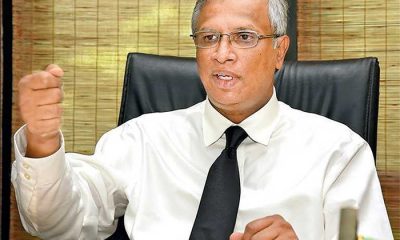
 News4 days ago
News4 days agoITAK denies secret pact with NPP
-

 Sports7 days ago
Sports7 days agoChamika, Anuka shine as Mahanama beat Nalanda



